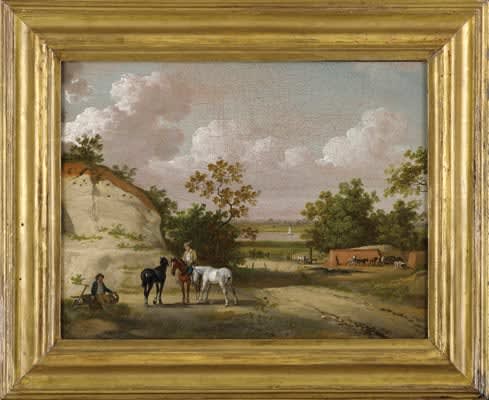
Julius Caesar Ibbetson
A Quarry Scene with Figures, 18th century
Oil on canvas
11 1/2 x 15 1/4 inches (29.5 x 39 cms)
Philip Mould & Co.
To view all current artworks for sale visit philipmould.com Julius Caeser Ibbetson was a leading landscape painter towards the end of the eighteenth century, perhaps best known for his...
To view all current artworks for sale visit philipmould.com
Julius Caeser Ibbetson was a leading landscape painter towards the end of the eighteenth century, perhaps best known for his scenes of rural life. His style shows clear influence from the seventeenth century Dutch naturalist painters and his work is characterised by his enigmatic depiction of figures and animals.
Ibbetson’s work shows a clear interest with the relationship between people and landscape, his work frequently depicting scenes of industry and labour, most commonly based around the Welsh landscape. Ibbetson’s connection with Wales began in 1792 when, along with John ‘Warwick’ Smith, he embarked on an extensive expedition. The works he produced in Wales during this period act as invaluable sources of social documentation, transcribing visually the scenes of industry which were so pioneered in later years by the likes of J.M.W Turner.
In the present work we see a more romanticised view of the British countryside, two figures converse in front of what is assumed to be the toils of their labour, seen in the chalk pit beyond. It is perhaps due to the horizontal composition of the painting that betrays a Dutch influence, however the distinctive combination of the earth-brown colouring and the greens observed in the foliage, reaffirms Ibbetson’s influence and awareness of the British School style.
Julius Caeser Ibbetson was a leading landscape painter towards the end of the eighteenth century, perhaps best known for his scenes of rural life. His style shows clear influence from the seventeenth century Dutch naturalist painters and his work is characterised by his enigmatic depiction of figures and animals.
Ibbetson’s work shows a clear interest with the relationship between people and landscape, his work frequently depicting scenes of industry and labour, most commonly based around the Welsh landscape. Ibbetson’s connection with Wales began in 1792 when, along with John ‘Warwick’ Smith, he embarked on an extensive expedition. The works he produced in Wales during this period act as invaluable sources of social documentation, transcribing visually the scenes of industry which were so pioneered in later years by the likes of J.M.W Turner.
In the present work we see a more romanticised view of the British countryside, two figures converse in front of what is assumed to be the toils of their labour, seen in the chalk pit beyond. It is perhaps due to the horizontal composition of the painting that betrays a Dutch influence, however the distinctive combination of the earth-brown colouring and the greens observed in the foliage, reaffirms Ibbetson’s influence and awareness of the British School style.
Provenance
Exhibitions
Literature
Be the first to hear about our available artworks
* denotes required fields
We will process the personal data you have supplied in accordance with our privacy policy (available on request). You can unsubscribe or change your preferences at any time by clicking the link in our emails.